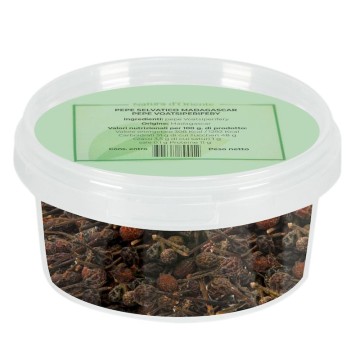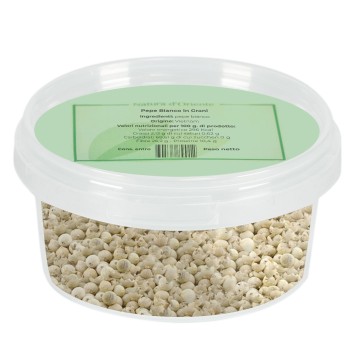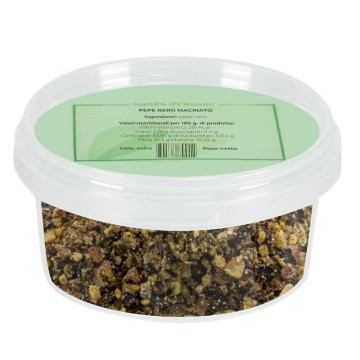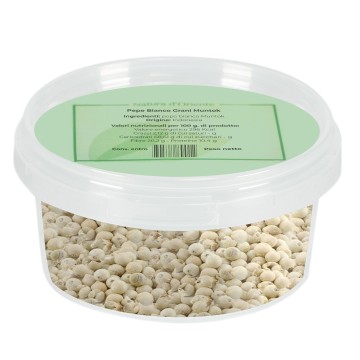Malagueta pepper is a false pepper known for its aroma reminiscent of ginger and cardamom (it is in fact part of the same botanical family) and for its spiciness reminiscent of pepper black.
The plant and the fruit
The botanical name of Malagueta pepper is Aframomum melegueta, it belongs to the Zingiberaceae family to which cardamom and, as the assonance with the name suggests, ginger also belong. In fact, the family takes its name from the genus Gingiber which is ginger.
It is a perennial herbaceous plant native to the marshy environments located along the West African coast.
It has purple trumpet-shaped flowers arranged in pods of 5-7 cm, inside there are numerous small reddish-brown seeds. The leaves are very long (25 cm and more) and narrow, similar to those of bamboo.
Place of origin and history
Costa Malagueta is the name of a stretch of Costa in Liberia that recalls the Portuguese domination over that area, according to some the Malagueta pepper takes its name from a port from which it was traded which was located in this area, but according to other sources it is the opposite, the coast took its name from this cheaper substitute for black pepper that the Portuguese traded from this area. What is certain is that the marshy areas along the coasts of the Ivory Coast of Guinea and of the other countries bordering the Gulf of Guinea are the place of origin of the Malagueta pepper. In Europe in the ancient world it was unknown, it was introduced only in the Middle Ages (it is mentioned in documents of the 1200s), then for some centuries (from the mid-1400s onwards) the spice was very popular, to be finally essentially forgotten during the nineteenth century. century. In practice, when black pepper began to arrive by sea more and more quickly and easily, the African pepper that had been a substitute on the tables of Europeans began to lose popularity. At the beginning of the 1800s it was now used almost exclusively to flavor sausages and beer, until Great Britain even banned its use to flavor alcoholic beverages, which definitively brought down imports. In the Encyclopaedia Britannica of 1855 we read that the grains of paradise (another common name by which Malagueta pepper is known) "have limited uses in veterinary medicine but are used for the most part illegally to give a fictitious strength to liqueurs of malt, gin and cordials. "
Properties of Malagueta pepper
The populations of the areas of origin used Malagueta pepper attributing to it properties common to other spices: diuretic, digestive and warming properties of the body . When chewing the grains of heaven, a sensation of warmth pervades the body. Guinea pepper is also attributed slimming capacities, even by modern natural medicine, according to some the mechanism with which it would act is precisely that of thermogenesis (also in this case the same characteristic is attributed to other spices, for example example of black pepper. The plant among the local populations also had a strong symbolic and traditional value, the Africans translated into the Caribbean as slaves imported the use of this spice also in Voodoo rites . Of course they could not lack of aphrodisiac and anti-inflammatory effects. But what does modern science say? Some studies have at least partially confirmed some anti-inflammatory abilities and as regards aphrodisiac abilities, a greater induced sexual activity has been found in rats.
Curiosities about Malagueta pepper
Malagueta pepper is suspected of having beneficial effects on cardiovascular health, at least that of… lowland gorillas. This is why we insert it as a curiosity and not among the properties, admitted and not granted that this benefit on great apes is real what is true in gorillas is not said to be true in humans. What has been noted is that lowland gorillas housed in zoos, however well they are kept, frequently suffer from heart problems not found in those living in the wild. Some zoologists have hypothesized that those who live free have some protective factor that would come to them from their diet and it has been observed that Malagueta peppercorns enter massively into their usual diet.
Guinea pepper in the kitchen
In the cuisine of the places of origin (coasts of West Africa, in particular the Gulf ofi Guinea) is used above all to flavor lamb and grilled fish, in North Africa it enters the preparation of some spice mixes, such as the Tunisian Qâlat daqqa (or five Tunisian spices) which is composed of: cloves, nutmeg, cinnamon, black pepper and Malagueta pepper and is used to flavor lamb and vegetables.
Prawns with Guinea pepper
- Ingredients for 4 people
- Prawns 16
- Guinea pepper in grains 5
- Oranges 1
- Pink grapefruit 1
- Extra virgin olive oil 4 tablespoons
- Salt to taste
Preparation
1) Clean the prawns: first remove the head and shell, then remove the black gut.
2) Heat a round of oil in an iron pan and when it is hot, place the prawns on it.
3) When one side of the prawns is well browned, turn them on the other side to cook, then remove them from the heat.
4) Crush a few grains of Guinea pepper in a mortar and distribute a generous amount over the prawns.
5) Cut the raw wedges of the pink and orange grapefruit. (Raw cutting means first removing the peel and white rind with a sharp knife without affecting the pulp and then extracting the naked wedges).
6) Serve the prawns accompanying them with the citrus wedges.
7) Season the citrus fruits with a drizzle of oil and salt and serve.
Recipe source: Cookaround.com









 No reward points for this product.
No reward points for this product.















